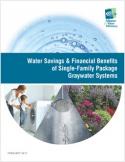Water Savings and Financial Benefits

Associated with Single-Family Package Graywater Systems
Planners, designers, decision makers, and researchers currently lack the information necessary to determine if graywater reuse systems are viable, safe, and provide cost-effective potable water savings. At the same time, these professionals and other stakeholders are increasingly under pressure to promote and/or incentivize the use of single-family packaged graywater reuse systems.
Recognizing this dynamic, the AWE Water Efficiency Research Committee wanted to develop a resource that would help industry professionals perform cost-benefit analyses for single-family packaged graywater systems.
The report includes easy-to-follow steps for determining the cost-benefit ratio, which gives utilities justification in choosing to include or exclude graywater systems from their program offerings. The report emphasizes that the results of a cost-benefit analysis will vary from utility to utility, but does set out some guiding principles that are the same everywhere. Specifically, it finds that graywater reuse programs are better suited as long-term, ongoing programs, and that several variables, such as long irrigation seasons and high home occupancy rates, impact the potential for customer savings. It also stresses the fact that the volume of water savings achieved via the use of a graywater system is not equal to the volume of graywater generated or collected—It is equal to the volume of potable water savings achieved by the homeowner.
Click here to download the full report ![]()
Click here to download the full report (Canadian Version) ![]()
A unit cost comparison is another resource developed for this project. Click here to read more about unit cost evaluations ![]() across the U.S.
across the U.S.
This report was made possible with funding from the East Bay Municipal Utility District ![]() and the Portland Water Bureau,
and the Portland Water Bureau, ![]() and with grant support from the California Department of Water Resources.
and with grant support from the California Department of Water Resources. ![]()





